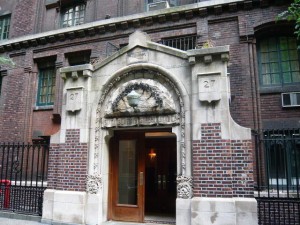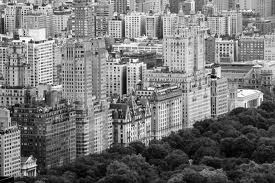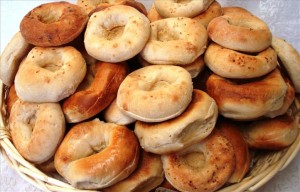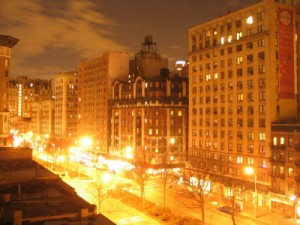Like the Huns and Visigoths sacking Rome, the Yups swooped down on Manhattan’s Upper West Side and destroyed scores of Mom-and-Pop shops, idiosyncratic, eccentric and full of flavor. Only big time operations can afford today’s rents (HG has written about the hapless search by a woman who wanted to open a bookshop in the neighborhood and found nothing that rented for less than $40,000 a month). HG/BSK began their life together in May 1963.Their residence was an artist’s studio in 27 W. 67th Street, a building constructed by a group of artists (Childe Hassam among them) in 1903. The HG/BSK connubial nest consisted of a big, high ceilinged studio with a wide expanse of windows awash with north light. Modest sized kitchen (big enough to accommodate a dining table). Bathroom with a giant tub. Small bedroom (once a changing room for models). A romantic apartment on a block renowned for the arts. (The Hotel Des Artistes was next door.. The restaurant in the Des Artistes featured gently naughty murals by Howard Chandler Christy and the building housed at times such luminaries as Noel Coward, Robert Lowell, Elizabeth Hardwick and Fanny Hurst). The rent for HG/BSK’s urban paradise was $147 a month. The 67th Street liquor store was on the corner and sold very good splits of champagne for $1.25. Nice little grocery/delicatessen on Columbus Avenue dispensed good bread, freshly made soups and salads. A short walk to good, affordable restaurants–Fleur de Lis for French food and Volk’s for German food. And, yes, Zabar’s was in business on Broadway, just a modest Jewish “appetizing” store, not the food megalopolis of today. West Side memories swept over HG today as HG examined a full page ad in the April 24-May 4 issue of New York Magazine. “27 W. 67TH STREET” was the headline. The ad detailed the glories of a duplex apartment in the building. The price: $4,950,000. “Hey, HG,” mused BSK, “If you’ve got a spare $5,000,000 tucked away somewhere we could buy it and start over again.”
27 W. 67th
April 27th, 2014 § 0 comments § permalink
Christmas Restaurant Nostalgia Part 5: Great Shanghai
December 20th, 2013 § 0 comments § permalink
A Christmas wander many decades ago on the then un-gentrified, rough-around-the-edges Upper West Side of New York City: With the kids well insulated against the cold, HG/BSK strolled north on Broadway. Passed Zabar’s, the temple of great smoked fish, bread and cheese. Much smaller then. Passed the New Yorker cinema (perpetually playing “The Sorrow and the Pity”). Passed The Symphony (then a movie house, not a performing arts center). Passed The Thalia (the tiny, eccentric movie theater that showed only the great classics–foreign and domestic). Passed the Senate Cafeteria (the place where Holocaust survivors drank endless cups of tea and provided habitué I.B. Singer–who relished the Senate tunafish salad–with material for his Nobel Prize-winning fictions). Passed the 96th Street newsstand (the best and busiest in New York). Arrived at the destination on 98th: The Great Shanghai Chinese Restaurant. Friends and their children were waiting. What a lovely way to spend a Christmas holiday late afternoon — gathered around a big round table with hungry pals devouring savory Chinese food. The Great Shanghai was large and loud, ruled by an imperious Chinese lady. The food was wonderful and the menu was both expansive and very inexpensive. The kids loved the dumplings and noodle dishes. The adults concentrated on the seafood — exceptional lobster, shrimp, scallop and crab dishes. Plus whole fish steamed with ginger, garlic and black beans or fried and topped with a fiery Szechuan sauce. After farewells, HG/BSK and the kids (who were anticipating dessert) picked up sweet good things at Babka Bakery on 79th and ice cream at adjacent Gourmet Treats. Yes, it was the Sixties and America was involved in domestic turmoil and bloody, wasteful war (So, what else is new?) but HG/BSK could put peace marching and civil rights activism aside and enjoy the delights of food and family.
Christmas Restaurant Nostalgia Part 4: Paramount Dairy
December 15th, 2013 § 0 comments § permalink
When HG/BSK lived (with famille) in their spacious rent controlled paradise on New York’s W. 79th Street, HG would escape from the Christmas holiday jingles and saccharine melodies by visiting a stronghold of traditional Jewishness: Paramount Dairy Restaurant on W. 72nd. The stroll on Broadway during the Upper West Side’s pre-gentrification days was always interesting. HG passed culinary landmarks like Daitch Dairy, Babka Bakery, Izmir Pizza, Gitlitz Delicatessen, Citarella Fish Monger. Fellow strollers included junkies, female sex workers, muggers, burglars, crazy ladies talking to themselves, sad eyed refugees from the Nazi terror; and, the usual crowd of West Side intellectuals, artists, writers and bohemians. On almost every block, HG would pause for a chat with a friend or acquaintance. Once in the Paramount, HG was seated at a table adorned with a huge bowl of breadstuffs — each the best of its kind: rye and pumpernickel bread, bialys, pletzels, challah. A dozen pats of unsalted butter. No Christmas decorations. No Chanukah decorations (not even a minor league menorah). Very refreshing. HG would order warm gefilte fish (a note to the uninitiated–this is a fresh water fish dumpling, a Jewish quenelle). This was served in a bowl of fish broth with a boiled potato and carrot. Accompanied by blazing horse radish. HG would dip thick slices of challah in the fish broth. Very comforting. This was followed by kasha varnishkes with mushroom gravy (HG recently wrote about this dish). Many cups of coffee and overindulgence in buttered bialys and pletzels. Refreshed and Judaized, HG was then ready for another onslaught of Bing Crosby and “Silent Night.”
The West Side Is (was) The Best Side
April 15th, 2013 § 0 comments § permalink
HG has written frequently about the food heaven that was the Upper West Side of Manhattan. Yes, Zabar’s, Murray’s and Barney Greengrass remain — temples of smoked fish and other delicious treats. But, in the days long before the UWS became fully gentrified there were scores of Mom-and-Pop shops, eccentric ethnic restaurants and corner greengrocers that defined the neighborhood’s culinary bent — all have disappeared, crushed by the real estate steam roller. When HG and BSK lived on the West Side during the 1960s and early 1970s the neighborhood was a bastion of rent control. Vast, affordable apartments were legion. Naturally, this attracted writers, artists, musicians, dancers, intellectuals, etc. The neighborhood had an edge. There were plenty of muggers and drug addicts. Petty larceny was the norm. Crazies, huddled in layers of clothing during the warmest weather, wandered the streets mumbling their interior monologues. At night, hookers appeared. There was a melancholy haze over the benches on Broadway where Holocaust survivors, often displaying their concentration camp tattoos, sat ringed in exhaust fumes and polluted sunshine. The great, Nobel Prize-winning author I.B. Singer, a small, pale man in a dark suit and fedora, would chat in Yiddish with these men and women (when he wasn’t feeding pigeons). Impecunious old European refugees favored the Senate Cafeteria on Broadway near 96th Street where they argued endlessly over cups of tea. HG and BSK lived in The Hereford, a moldering 12-story apartment house between West End Avenue and Riverside Drive (glorious views of the Hudson River and the New Jersey Palisades). The building was a repository of the arts. HG and BSK’s dear friend, the composer Michael Small lived with his wife, Lynn, on the fourth floor (HG and BSK lived on the lofty 12th). The Small’s apartment was unusual. Michael’s classmate at Williams College, Charles Gwathmey, the extraordinary architect, had ripped out walls in the apartment creating an exuberant space defined by his beautifully crafted cabinetry. Michael’s grand piano was at stage center. Peter Boyle, the actor (before jumping to fame in Young Frankenstein) lived in the building and joined HG and BSK at a Chinese cooking class. Ted Solotaroff, the visionary critic and editor (founder of The New American Review and lifelong friend of Philip Roth) became a pal of HG and BSK. Here’s a vignette of life at The Hereford: Early one evening Michael summoned HG and BSK to his apartment where he played some of his score to the film Klute (a hit with Jane Fonda as a call girl-in-peril). He went on to write the scores for many memorable films induing All The President’s Men and Marathon Man. After dinner we all went to a literary event at Ted Solotaroff’s apartment. Here, we heard Richard Howard, the poet and translator, read Robert Browning’s My Last Duchess. Memorable. Sadly, Small, Boyle, Gwathmey, Singer and Solotaroff are all gone. Richard Howard is still a figure in New York literary life. And HG continues to remember it all with great fondness.
Young New Yorkers Living in Expensive Closets: Read This And Weep.
October 10th, 2012 § 0 comments § permalink
Some 48 years ago (seems like yesterday). HG, BSK, their two adorable children, their live-in mother’s helper and their poorly trained but decorative standard poodle, lived in a 12th floor Upper West Side apartment with dramatic views of the Hudson River and the New Jersey Palisades. A very spacious residence. Big living room. Big, separate dining room. Nice windowed kitchen and pantry. Four bedrooms and three baths (one en suite). The rent: $274 a month (later raised to $292 and a similar apartment in the same building now rents for $15,000 a month). Ah, rent control, you lovely bit of legislation (of course, obtaining this rent controlled paradise involved some bribery, chicanery and corruption). This did not shock HG, a born and bred New Yorker. In those days the Upper West Side was affordable and diverse. There was still a heavy Jewish influence. Big time theater and entertainment folks (Abe Burrows, Leonard Bernstein, Isaac Stern and many more) lived on Central Park West alongside many affluent professionals and business persons. Side streets from Central Park West to Broadway were gritty (except for W. 67th Street, site of the Des Artistes apartment house and many studios of painters and musicians). Riverside Drive and the Avenues and cross streets west of Broadway were filled with intellectuals and creative types who had more brains and talent than money. Forget Greenwich Village. The Upper West Side was the home of professors, critics, novelists, dancers, journalists, composers, actors, musicians and school teachers. Lots of European intellectuals who had fled Hitler and many Holocaust survivors (the little, pale, Nobel Prize winning writer, Isaac Baashevis Singer, who lived on W. 86th Street, often wrote about them). The Heresford (West Side apartment houses often had British names, a touch of Anglophile class) where HG and BSK lived, had much artistic ferment. Among its residents were Peter Boyle (before Hollywood and TV fame); film composer Michael Small, the critic and editor Ted Solotaroff; Gary Null, the health and sex writer, guru and radio personality. There were also some Broadway dancers, the cantor of a major synagogue and lesser artistic lights. The Upper West Side was filled with movie theaters showing art films (the New Yorker, Thalia and Symphony) and plus the first run houses (Loew’s 83rd, the Beacon,etc.). Food was a neighborhood obsession. Zabar’s, of course, but also Murray’s (preferred by some smoked fish aficionados) and Barney Greengrass (unsurpassed sturgeon). Middle European restaurants like Eclair and dairy restaurants like Steinberg’s and Paramount. Gitlitz’ Delicatessen on Broadway and 78th ( much superior in HG’s informed opinion, to Katz’s, Carnegie or 2nd Avenue Deli). The jewel of the West Side was the Tip Toe Inn (on Broadway near 86th Street). A huge place with a huge menu. Everything was delicious and inexpensive (the New York Public Library has a nice collection of old menus….Here’s a link to Tip Toe’s 1954 menu. Be astonished). There was a rotisserie in the Bretton Woods Hotel (86th and Broadway) that barbecued ducks and chickens. Sunday dinners for HG and BSK often featured one of those juicy, crisp skinned ducks and an avocado-sweet onion-sliced orange salad. Chinese restaurants were clustered around Broadway and 96th and they were very good (the first Szechuan restaurant in New York was on Broadway and 95th). There were also some Cuban/Chinese places where you could get good shrimp dishes plus Moros y Cristianos (black beans and rice) Fairway didn’t exist but for those who liked to eat at home there were butchers like Endicottt Meats and Nevada Market (where you could get some exotic stuff including bear, in season). Good bakeries. Mom and Pop greengrocers. Citarella’s for fish. Broadway Nut Shop for sweets. Daitch Dairy (79th and Broadway) for tub butter and cheese. Bretton Wood Rotisserie for barbecued ducks. HG and BSK were not plutocrats but could afford all of these good things. Yes, the Upper West Side had lots of junkies, hookers, muggers and burglars. Their presence made West Siders feel superior to residents of the antiseptic Upper East Side. Now, let HG make you young folks really jealous. HG, BSK and family spent all summer plus spring and fall weekends at their Fire Island home. Built atop a dune it had panoramic views of the Atlantic Ocean and Great South Bay sunsets. The family bought it for $40.000. HG’s first Fire Island house (in 1959) cost $4,000 ($1,000 for land and $3,000 for two bedrooms, bathroom, kitchen, living room and deck). In 1960, HG added two more bedrooms, another bathroom and additional decking. Cost: $2,000. That’s right. The numbers for these Fire Island properties are correct. Read and weep.
The Golden Age of Food On The Upper West Side.
December 21st, 2011 § 182 comments § permalink
It was 1963. HG and BSK were beginning their marriage in an artist’s studio apartment on West 67th Street just off Central Park West. Huge high ceilinged living room with north facing floor to ceiling window, small kitchen, small bedroom ( former model’s changing room), big bathroom with enormous tub. Very romantic. The rent: $140 per month.
This was The Golden Age Of Food On The Upper West Side. Gentrification and escalating real estate prices removed the gritty, funky luster. The neighborhood had junkies, muggers, burglars, hookers and bag ladies. It also had tons of artists, writers, academics and free ranging intellectuals lured by big apartments and cheap rents.
Here’s a smattering of the food and drinks establishments that delighted the newlyweds: 67th St. Wines (67th and Columbus): Splits of good champagne for a dollar. Volk’s German Restaurant (78th and Columbus): Bratwurst heaven. Fleur de Lis French Restaurant (65th off Broadway?): Escargots. Sole. Steak frites. C & L Restaurant (70th and Broadway?): Huge, Exceptional apple pancakes. Vast menu.  Tip Toe Inn (86th and Broadway). A sister restaurant to C & L with a great delicatessen. Also, notable chicken in the pot. Recently the Tip Toe Inn was featured on the show Mad Men and they were quite true to most of the original details. Zabar’s (81st and Broadway): Need HG say more? Now a New York landmark.
Tip Toe Inn (86th and Broadway). A sister restaurant to C & L with a great delicatessen. Also, notable chicken in the pot. Recently the Tip Toe Inn was featured on the show Mad Men and they were quite true to most of the original details. Zabar’s (81st and Broadway): Need HG say more? Now a New York landmark.
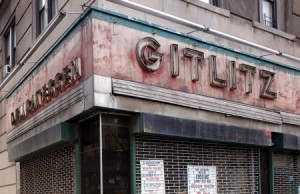 Nevada Market (80th and Broadway): Steaks. Chops. Chicken. Citarella’s (74th and Broadway): Everything fresh from the sea. Paramount Famous Jewish Dairy Restaurant (72nd west of Broadway): Blintzes. Gefilte fish. Kasha varneshkes. Steinberg’s (84th and Broadway): Same cuisine as Paramount but classier. Very good herring. Great Shanghai (98th and Broadway) Chinese lobster and shrimp dishes. Dumplings. Szechuan (95th and Broadway) Fire on a plate. New York’s first and best Szechuan restaurant. Broadway Nut Shop. (East side of Broadway and 81st): Encyclopedic array of fresh roasted nuts, dried fruits and candy treats from across the globe. Eclair Bakery and Restaurant (72nd Street): Vienna, Berlin, Budapest and Warsaw transplanted in New York. Senate Cafeteria (96th and Broadway): Where I.B. Singer ate his tunafish salad in the company of tea sipping, Yiddish speaking European survivors.
Nevada Market (80th and Broadway): Steaks. Chops. Chicken. Citarella’s (74th and Broadway): Everything fresh from the sea. Paramount Famous Jewish Dairy Restaurant (72nd west of Broadway): Blintzes. Gefilte fish. Kasha varneshkes. Steinberg’s (84th and Broadway): Same cuisine as Paramount but classier. Very good herring. Great Shanghai (98th and Broadway) Chinese lobster and shrimp dishes. Dumplings. Szechuan (95th and Broadway) Fire on a plate. New York’s first and best Szechuan restaurant. Broadway Nut Shop. (East side of Broadway and 81st): Encyclopedic array of fresh roasted nuts, dried fruits and candy treats from across the globe. Eclair Bakery and Restaurant (72nd Street): Vienna, Berlin, Budapest and Warsaw transplanted in New York. Senate Cafeteria (96th and Broadway): Where I.B. Singer ate his tunafish salad in the company of tea sipping, Yiddish speaking European survivors.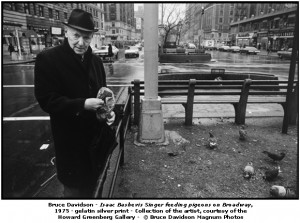
As HG remarked, this is just a smattering. There was much more. Sadly, only Zabar’s, Greengrass and Citarella’s remain. On the bright side: The West Side has added Fairway.
